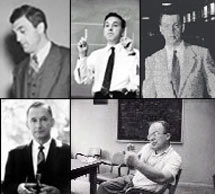

Monday - April 10, 2006
SLAC Today is
available online at:
http://today.slac.stanford.edu
In this issue:
50-Year Anniversary of "Project M"
Dorfan Today: Case Closed... Successfully
SNIC Conference Brings Three Fields Together
 |
 |
|
Monday - April 10, 2006 |

Organizers of the first Project M meeting, 1956. Clockwise: F. Bloch (Stanford News Service photo), R. Hofstadter (Carl Oliver / Stanford News Service), E. Ginzton (Ginzton family photo), W.H.K. Panofsky (Stanford News Service), and L. Schiff (Hank Kranzler photo). 50-Year Anniversary of "Project M"Fifty years ago today, the first official "Project M" meeting was held at the home of Professor W.K.H. "Pief" Panofsky, in Los Altos Hills. On the heels of the success of the Mark III accelerator at Stanford University, physics faculty members had begun thinking about building an even higher-energy linear electron accelerator. As recounted by Doug Dupen in Chapter 3 of The Stanford Two-Mile Accelerator (more commonly known at SLAC as "The Blue Book") Panofsky, Leonard Schiff, Robert Hofstadter, Felix Bloch and Ed Ginzton had previously held a few informal meetings to discuss the possibility of building "a Multi-GeV" accelerator. The get-together at 8:00 p.m. on April 10, 1956 was the first official organizational meeting of what was hoped to be the next big project for physics at Stanford. Read more... |
||||||||||||||||||||||||||
|
|
||||||||||||||||||||||||||

Case Closed... SuccessfullyI want to congratulate the Accelerator Division, BABAR, MFD, the SLAC shops, and the many others who contributed to getting PEP-II running again at high luminosity. This team worked incredibly long and hard to discover the origins of an extremely elusive problem in an inaccessible region of the collider, was able to replace the damaged parts with a carefully orchestrated set of surgical steps, and then got everything up and running smoothly again within a matter of days. Resolving the problem involved some considerable detective work. PEP-II had been delivering record amounts of luminosity to the BaBar detector last October but, after a planned downtime, an unexpected problem surfaced in mid-December and quickly became chronic. When the current in the lower-energy ring (LER) topped roughly 1600 milliamps, just over half of the current needed to produce October's peak luminosity, short intense vacuum pressure spikes lasting a few seconds began to occur near the detector with increasing frequency, many resulting in a beam abort due to background conditions. As a result, PEP-II had to limp along with only half the desired current, and thus only half the luminosity. While still well above the luminosity the collider was designed to deliver, this fell short of what Babar needs to pin down new physics and other measurements of rare events. Read more... |
C-SPAN's Book TV to Broadcast ColloquiumA C-SPAN televison crew will tape today's colloquium, presented by Ann Finkbeiner. The talk will air on C-SPAN2 three or four times over the next few months. SLAC Today will post more information as it becomes available. SNIC Conference Brings Three Fields Together
The 2006 International Symposium on the Development of Detectors for Particle, Astroparticle and Synchrotron Radiation Experiments concluded at SLAC last week. "These are the three fields of research in which SLAC is now involved," said conference organizer Vera Lüth. "By bringing more than 150 researchers from these fields together, the symposium offered opportunities for a wide range of discussions and exchange of ideas and experience." According to Lüth, the enormous variety of presentations offered insight into ingenious detector developments and applications, ranging from devices measuring e-Volt signals near zero temperature to high-energy jets of Tera-eVolts expected at the future Large Hadron Collider at CERN. "Particle physics has a lot to offer astrophysics and photon science, and vice versa," she said. "Research in these fields can also stimulate new particle physics detection methods." |
Events (see all | submit)
Access (see all)
Announcements
|
||||||||||||||||||||||||
| | ||||||||||||||||||||||||||
What's Cookin' at the Linear Cafe (see weekly menu)
|
||||||||||||||||||||||||||
|
|
||||||||||||||||||||||||||
 <%
Response.AddHeader "Last-modified", getArticleDate()
'Response.AddHeader "Last-modified","Mon, 01 Sep 1997 01:03:33 GMT"
'Monday, December 06, 2010
%>
<%
Response.AddHeader "Last-modified", getArticleDate()
'Response.AddHeader "Last-modified","Mon, 01 Sep 1997 01:03:33 GMT"
'Monday, December 06, 2010
%>View online at http://today.slac.stanford.edu/. |
||||||||||||||||||||||||||